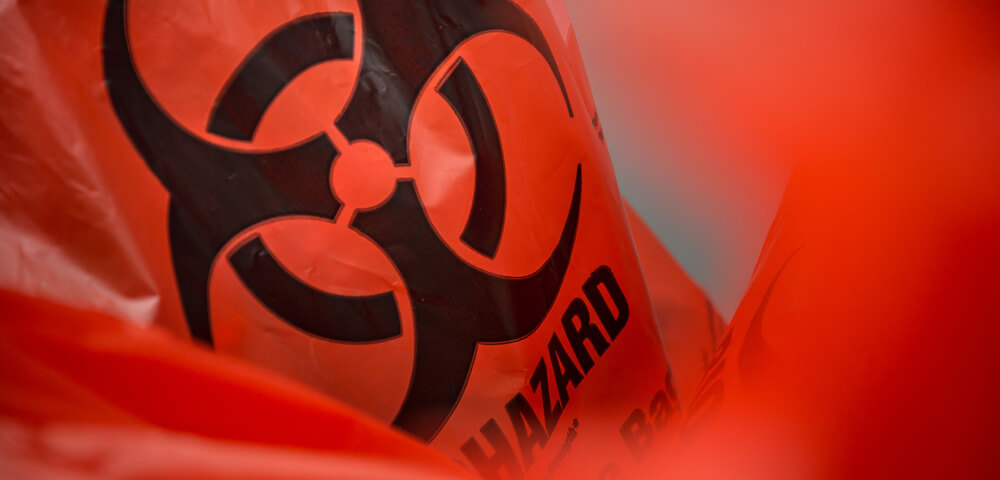
/ IN THIS BLOG
Within the medical industry, numerous terms and definitions are related to different types of medical waste, which can get confusing when determining how to dispose of such waste. One such term that's essential for doctors and any member of the medical community to know and understand is "regulated medical waste."
The differences between regulated medical waste and potentially hazardous medical wastes are not always easy to define. That’s why it is imperative that not only health professionals, but also housekeeping and janitorial staff, are aware of the difference between wastes that belong in the regulated or ‘non-regulated’ categories when it comes to disposal.
This knowledge prevents potentially hazardous wastes from ending up in landfills and protects not only healthcare workers but the general public and the environment from dangerous substances. Know the difference and what special requirements need to be taken to properly dispose of regulated medical wastes.
01 / What is Regulated Medical Waste?
The Environmental Protection Agency (EPA) strictly defines this type of waste as anything that has potentially been contaminated with blood, blood components, or body fluids, or any other potentially infectious materials (OPIM).
Adding to the potential confusion, regulated medical waste is also known by several different names such as biomedical waste, biohazardous waste, infectious waste, and red bag waste. By virtue of it often containing blood or bodily fluid contamination, such waste is often placed in red biohazard bags or bins and called simply red bag waste. Different states – even different hospitals – may give regulated medical waste a different name, but when you break it down, it will contain any blood-contaminated product or specific body fluids, or anything that has the potential to spread disease, virus, bacteria, and so forth to someone handling that waste.
02 / Who Regulates Medical Waste?
Medical waste and its segregation and disposal is not regulated by the Environmental Protection Agency (EPA) as often supposed, but by state environmental offices and/or health departments such as state Departments of Natural Resources or state Waste Management Programs.
For example, medical waste regulations in Wisconsin fall under the purview of the Wisconsin Department of Natural Resources. This state defines medical waste as infectious waste.
Arizona regulates its medical waste under their state’s Solid Waste Management Program. It defines medical waste as ‘any solid waste which is generated in the diagnosis, treatment or immunization of a human being or animal… but does not include hazardous waste as defined in A.R.S. §49-762.04.’
Other states provide their own definitions. To find them, turn to your state government’s code of regulations or administration code definitions. Storage regulations may also differ between states. So what, exactly, is regulated medical waste?
03 / Importance of accurate paperwork!
Within medical settings, whether in a doctor's office, a hospital, an urgent care center, or even a tattoo or body-piercing parlor, many items might come in contact with blood, body fluids, or other infectious materials. These items most often include:
Medical sharps (needles, syringes, scalpels, medical knives, etc.)
Used Band-Aids, gauze, or bandages
Gowns (worn by healthcare providers or patients)
Masks (worn by healthcare providers or patients)
Keep in mind that this list is not complete. Every state will have precise definitions for what is considered medical waste and how it is to be regulated in that state. Once an item, from patient or healthcare provider, comes into contact with potentially infectious sources, that item is then considered regulated waste.
04 / Can Regulated Medical Waste be disposed of in the Garbage?
Can regulated medical waste be disposed on in the garbage can? Absolutely not! Regulated waste is not common municipal or office trash and must be segregated from other ‘ordinary waste’ and disposed of in compliant containers or bags. It cannot simply go in the garbage due to its potential to create a health risk for anyone who comes in contact with that material.
Such wastes are to be segregated or separated from other types of waste as close to the point of origin as possible. Packaging requirements apply. For example, biomedical waste must be placed in easily identifiable red bags or containers that have been labeled or marked as ‘Biomedical’ or ‘Biohazard waste’. Such waste is to be stored in a separate area from other wastes. That space must also be properly ventilated and located to minimize exposure to the general public or animals and contained against entry except by authorized persons.
Containers of such waste must be sturdy and resist bursting or tearing as they are handled, stored, and ultimately transported off-site for disposal. Again, turn to your state’s governmental regulations regarding length of storage of medical wastes, as they do differ.
05 / What about Medications and Pharmaceuticals?
Medications and pharmaceuticals require special considerations in regard to disposal. Hazardous waste pharmaceuticals are regulated by the EPA and require specific management standards and processes. Detailed information from the EPA can be accessed here.
Expired medications and pharmaceuticals do not constitute regulated waste. Confusion regarding disposal processes occurs due to lack of knowledge between handling and disposal of a hazardous drug as opposed to a controlled substance. In addition, the protocol for expired medications is different than it is for blood-contaminated waste. Therefore, they fall under different umbrellas and procedural requirements.
06 / Properly Dispose of Regulated Waste
Don’t guess when it comes to disposal of any regulated medical waste. Know the definitions of your state. Know the difference between a hazardous pharmaceutical waste and a controlled substance when it comes to disposal. Healthcare providers or others who come into contact with regulated waste need to follow certain procedures and steps to ensure it is properly segregated and disposed of.
Education and training of personnel is essential. Every employee should be knowledgeable about what constitutes regulated medical waste. Awareness of the EPA's rules and maintaining compliance with the Occupational Safety and Health Administration (OSHA) and its Bloodborne Pathogens Standards can help eliminate confusion.
Ensure that any potentially blood-contaminated items from patient or healthcare provider are properly placed in red bag or red container waste bins as close to the point of origin as possible. All contaminated trash should go in that bin - and that bin only.
Sharps are to only be disposed of in compliant sharps containers. Any sharp should be placed in a puncture-resistant sharps container before being placed in a red bag or container or bin for disposal. This ensures the sharp edge or point doesn't poke, stick, or cut anybody dealing with this waste. The use of a puncture-resistant sharps container is a vital part of proper sharps disposal.
Remember that only regulated medical waste goes into the ‘red bag’ waste stream. Don’t mix biomedical or infectious waste with other types of waste. Never mix any non-hazardous waste with hazardous waste or all of it must be designated as hazardous waste.
Expired medications and pharmaceuticals don't belong in red bag waste. Improper training increases risk of accidents or exposure to needlestick injuries or contamination with hazardous or infectious materials. This leads to non-compliant medical waste disposal that not only puts people and the environment at risk, but puts your medical facility at risk for massive fines or even more serious consequences.
For additional information about regulated waste in the medical industry or how to properly dispose of such waste, contact a representative of MCF Environmental Services, a professional waste management company that serves medical professionals and facilities regardless of size. With over three decades of experience in the field, we focus on regulated waste management processes that ensure compliance and improved safety.
Robert Losurdo
President, COO








